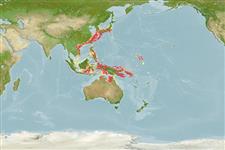>
Eupercaria/misc (Various families in series Eupercaria) >
Labridae (Wrasses)
Etymology: dewapyle: Name coming from the combination of the surnames of Mr Shin-ichi Dewa and Dr Richard L. Pyle, collectors of all type specimens; noun in apposition..
Environment: milieu / climate zone / depth range / distribution range
Écologie
marin; profondeur 65 - 99 m (Ref. 105428), usually 65 - 70 m (Ref. 105428). Tropical; 20°C - 24°C
Distribution
Pays | Zones FAO | Écosystèmes | Occurrences | Point map | Introductions | Faunafri
Western Pacific Ocean: from southern Japan (Iou-jima), Papua New Guinea and Fiji; including Indonesia.
Taille / Poids / Âge
Maturity: Lm ? range ? - ? cm
Max length : 5.6 cm SL mâle / non sexé; (Ref. 105428)
Description synthétique
Clés d'identification | Morphologie | Morphométrie
Épines dorsales (Total) : 10; Rayons mous dorsaux (Total) : 11; Épines anales: 3; Rayons mous anaux: 12. This species is distinguished by the following set of characters: scale rows in longitudinal series 41-42 (mode 41); pored lateral-line scales 39-40 (39); gill rakers 12-13 (13); least distance between anteroventral margin of orbit and maxilla 1.2-3.7% (mean 2.5%) of SL; without red blotches superimposed and protruded on midlateral red stripe in adults and young; without yellow stripe on dorsal fin; the space between upper and midlateral red stripes vivid yellow; in young individuals, black blotch superimposed on midlateral red stripe on opercle, blotch fading with growth (Ref. 105428).
An epibenthic species found on sandy, rubble and coral bottoms, with individual males sometimes
accompanied by a small harem (pers. comm. K. Nishiyama). It is most commonly seen at depths of 65-70 m during cold upwelling events (temperatures of 20-24C°) with adults observed to dive into the burrows of other organisms when startled, at Menjangan and Nusa Penida islands off Bali, Indonesia (Ref. 105428).
Life cycle and mating behavior
Maturities | Reproduction | Spawnings | Egg(s) | Fecundities | Larves
Fukui, Y. and H. Motomura, 2015. A new species of deepwater wrasse (Labridae: Terelabrus) from the western Pacific Ocean. Zootaxa 4040(5):559-568. (Ref. 105428)
Statut dans la liste rouge de l'IUCN (Ref. 130435)
Menace pour l'homme
Harmless
Utilisations par l'homme
Outils
Articles particuliers
Télécharger en XML
Sources Internet
Estimates based on models
Phylogenetic diversity index (Ref.
82804): PD
50 = 0.7500 [Uniqueness, from 0.5 = low to 2.0 = high].
Bayesian length-weight: a=0.00501 (0.00207 - 0.01214), b=3.15 (2.94 - 3.36), in cm total length, based on LWR estimates for this (Sub)family-body shape (Ref.
93245).
Niveau trophique (Ref.
69278): 3.3 ±0.4 se; based on size and trophs of closest relatives
Résilience (Ref.
120179): Haut, temps minimum de doublement de population inférieur à 15 mois (Preliminary K or Fecundity.).
Fishing Vulnerability (Ref.
59153): Low vulnerability (10 of 100).
